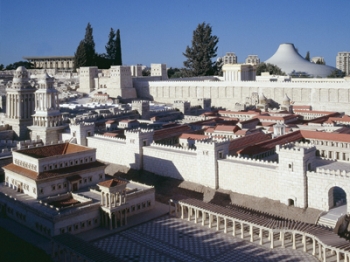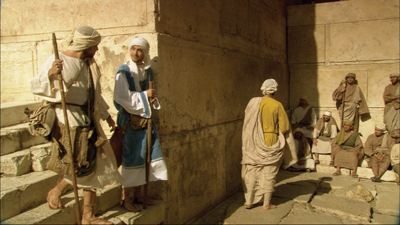|
MUSEUM
Jerusalemís Glory
Days
The famous model at the Holyland Hotel
depicts Jerusalem in the Second Temple period, one of the most
fascinating and vibrant chapters in the cityís history. The model has
found a new home at the Israel Museum, right next to the Dead Sea
Scrolls, which were written in the same period. by Miriam Simon
Walk past the Shrine
of the Book and suddenly Herodís Temple comes into view, the sun
glinting off the gold trim. The year is 66 CE. All thatís missing are
the thousands of people flowing into the vast Temple courtyard, walking
among the white houses in the City of David, and strolling between the
red-roofed buildings of the Western Hill.
The Second Temple
model opened to the public at the Israel Museum, Jerusalem, this July.
The model originally was built four decades ago, when Jerusalem was
divided and Israelis couldnít go to the Old City and see the sites there
for themselves. Hans Kroch, owner and developer of the Holyland Hotel,
built a model of it in memory of his son Jacob, who fell in Israelís War
of Independence. The model took four and a half years to build and was
inaugurated in 1966.

The model in its new
home. (Meidad Suchowolski, courtesy of the Israel Museum)
A year earlier, the
Israel Museum and the Shrine of the Book, which houses the Dead Sea
Scrolls, had opened. Museum director James Snyder explains that it has
always been important to the museum to make sure that the Dead Sea
Scrolls donít just become relics, since they are artifactual treasures
connecting ancient to modern Israel and illuminating a benchmark moment
in the march toward monotheism in Judaism, Christianity, and Islam.
However, it has been a challenge to place the scrolls in the proper
contextual framework.
Ten years ago, the
museum renovated the area of the Shrine of the Book and restored the
scrolls. This July, it opened the Dorot Foundation Dead Sea Scrolls
Information and Study Center, in Memory of Joy Gottesman Ungerleider,
which is made up of an auditorium, classroom, public study facilities,
and a digital library. The study center, located next to the shrine, was
created so that the public and scholars can interact there and
electronically connect to researchers worldwide and have access to
ongoing research on the scrolls. The new underground theater shows a
film for the general public about that period of time in history.

A scene from the film at the new
information and study center at the Israel Museum.
Six months after the
museum began to develop the study center, Hillel Cherny, the grandson of
the developer of the Holyland Hotel, contacted the museum. Because of
the construction of an apartment complex at the Holyland site, the model
had to be moved. The Israel Museum grabbed the opportunity. Now there
was a way to put the Dead Sea Scrolls into a historical context.
The Second
Temple-period Jerusalem model was originally constructed under the
direction of Prof. Michael Avi-Yonah, one of the leading experts on
ancient Jerusalem. Since there werenít many excavations at the time, the
early 1960s, and he couldnít personally go into the Old City, Avi-Yonah
relied mainly on literary sources; Josephus describes the city, the
Mishna describes the Temple Mount and the Temple, and the New Testament
also has descriptions. In addition, Avi-Yonah looked at other ancient
cities from the Second Temple period and adopted some of their material.
The city then was twice the size of the Old City today.
In the wake of
excavations conducted after 1967, he found that some of his decisions
were right and some were wrong and so he started to correct the model.
The model is not intended to be archaeologically accurate, but it is a
three-dimensional illustration of ancient Jerusalem, showing the
architecture and topography of Jerusalem in the historical time in which
the Dead Sea Scrolls were created.
The museum had a
dormant acre of land right next to the Shrine of the Book. The model
takes up an acre, and as Snyder said, ďSome divine force over 40 years
kept this acre free.Ē The museum started to move the model a year ago.
One thousand pieces were moved in sixty days, on a flatbed truck that
went back and forth three times a day. Then the pieces were reinstalled
alongside the underground study center for the Dead Sea Scrolls and the
Shrine of the Book.
The path leading to
the model allows visitors to view the Temple Mount as if they were
standing on the Mount of Olives. The model is a day in the life of
Jerusalem in 66 CE, when the city was at its largest, the year of the
Great Revolt against the Romans. The model reconstructs the topography
and architectural character of the city as it was at that time. It shows
that Jerusalem was different from its neighbors because there is only
one sacred precinct and there are no statues among the monumental
buildings, unlike in other Roman-Hellenistic cities. It also clearly
shows how large the space the Temple Mount, Herodís Temple, takes from
the city.
Herodís Temple took
nine and a half years and 9,000 laborers to complete. It was described
in the ancient world as the most magnificent project of the time. The
model is made from Jerusalem stone, the local limestone, material from
which the city was constructed in ancient times and continues to be
constructed today.
Changes to the model
are made according to new finds and new proof in historical and
archaeological research. For example, archaeologists recently discovered
that the Siloam Pool is lower, larger, and stepped. It is the largest
known ancient mikvah (Jewish ritual bath) ever, and there was a street
leading from it up to the Temple Mount. As a result, the model will be
changed accordingly. On the other hand, not a single roof tile has been
found in excavations of Jerusalem to date; the decision to build red
roofs in the model was based on descriptions of other ancient cities.
However, this feature will not be changed because there are too many
tiles in the model.
The inner and outer
perimeters of the model are lined with promenades. The model is open to
the elements and even though there are some places to sit on the outer
perimeter, there is no protection from the sun and the rain for
visitors. People are not allowed to walk inside the walls of the model.
The museum has devised signs for four viewpoints at the outer perimeter.
The signs have a photograph taken from that viewpoint, highlighting
monuments. It corresponds with the audio guide of the model, which is
available to visitors with no additional fee.
The Israel Museum
has synchronized the two stories of Jerusalem and the Temple, and
the story of the Dead Sea Sect. Since the scrolls are part of the Second
Temple period, the model puts this period of time into context. The film
that the museum has created shows the life of one of the Dead Sea sects
and then focuses on a young priest in Jerusalem to show the religious
dynamics from the Second Temple period. (The film can be seen in English
or Hebrew; a French version will be available in December.) With this information in mind,
all it takes is a little imagination for visitors to go back to the
teeming and bustling streets of Jerusalem 2,000 years ago, with the
magnificent Temple dominating the scene.
This
article
appeared in ERETZ Magazine 105.
Click here to subscribe to ERETZ Magazine. |

